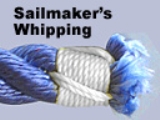
Sailmaker's Whipping
Encyclopedia

Whipping knot
A whipping knot or whipping is a binding of twine around the end of a rope to prevent the fibres of the rope from unravelling.When a rope is cut, there is a natural tendency for the cut end to fray. A whipping is one way to try to prevent this, by applying multiple turns of twine tightly around...
known. It is second only to the nearly indefatigable palm and needle whipping.
Technique
The twine is first threaded diagonally through the rope. The twine is then wrapped round the rope including the diagonally threaded end. A needle is then used to thread the two ends through the rope to enclose the wrapping turns. Finally a reef (square) or a string of reef (square) knots is tied. Then this string of reef (square) knots is pulled through the rope to bury the ends.Alternatives

West country whipping
The West Country Whipping is a quick practical method of using twine to secure the end of a rope to prevent it fraying. It has several advantages: it can be tied without a needle; it is simple to understand and remember; if the whipping fails, the loose ends can usually be re-tied to temporarily...
is a quick practical method of using twine to secure the end of a rope to prevent it fraying. Half hitches are tied alternately behind and in front of the rope until the width of the band of twine approaches the diameter of the rope. It has several advantages: it can be tied without a needle; it is simple to understand and remember; if the whipping fails, the loose ends can usually be re-tied to temporarily prevent the rope's end from fraying.
Fusing The end of many synthetic ropes can be melted using heat, e.g., a flame. While this is simple and quick, it tends to fail in ropes subject to heavy use. Ideally a rope's end should be both melted (if applicable) and whipped.

